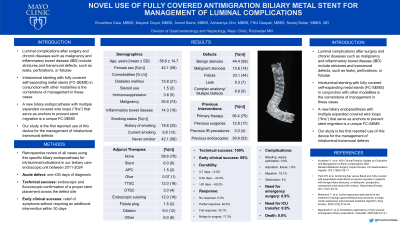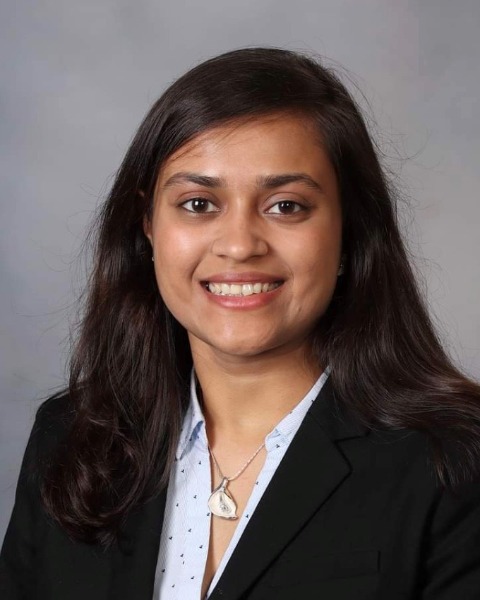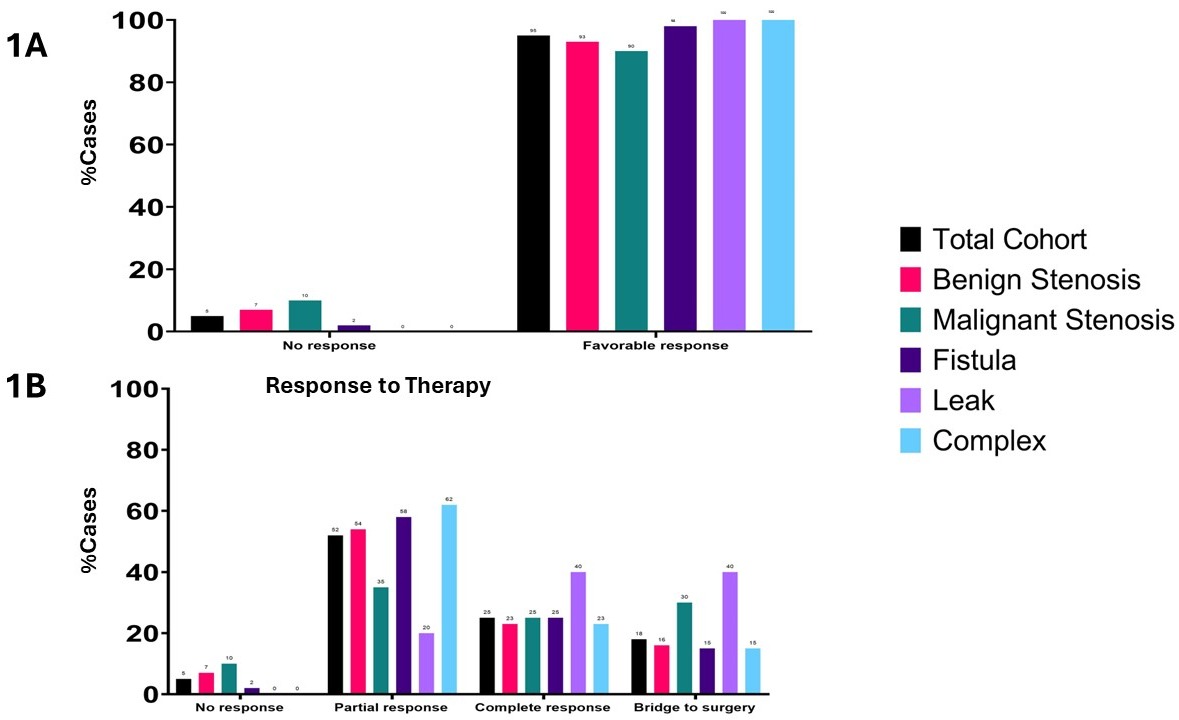Tuesday Poster Session
Category: Interventional Endoscopy
P4488 - Novel Use of Biliary Fully Covered Self-Expanding Metal Stent for Management of Intraluminal Transmural Defects
Tuesday, October 29, 2024
10:30 AM - 4:00 PM ET
Location: Exhibit Hall E

Has Audio

Khushboo Gala, MBBS
Fellow
Mayo Clinic School of Graduate Medical Education
Rochester, MN
Presenting Author(s)
Khushboo Gala, MBBS1, Mayank Goyal, MBBS2, Anmol Bains, MBBS2, Ashwariya Ohri, MBBS2, Fnu Deepali, MBBS2, Navtej Buttar, MD2
1Mayo Clinic School of Graduate Medical Education, Rochester, MN; 2Mayo Clinic, Rochester, MN
Introduction: Transmural defects like leaks, perforations, or fistulae involving a disruption in the wall of the gastrointestinal (GI) lumen are increasingly being managed endoscopically. Intraluminal stenting with fully covered self-expanding metal stents (FC-SEMS) in conjunction with other modalities is the cornerstone of management in these cases. A new biliary endoprosthesis with multiple expanded covered wire loops (“fins”) that serve as anchors to prevent stent migration is a unique FC-SEMS. Our study is the first reported use of this device for the management of intraluminal transmural defects.
Methods: We performed a retrospective review of all cases using this specific biliary endoprosthesis for intraluminal indications in our tertiary care endoscopic unit between 2011-2024. An acute defect was defined as one ≤30 days of diagnosis. Patient demographic and medical information were abstracted from the electronic medical records. Continuous variables were reported as mean ± standard deviation (SD), while categorical variables were reported as frequencies (%). Logistic regression modeling was performed to determine predictors of response to therapy.
Results: Our cohort comprised 199 patients, who were 38.7% (77) female with a mean age of 58.1 ± 15.0 years, with a mean follow-up of 397.4 ± 494 days (Table 1A). Defects were acute in 32.7% (65) of cases, most commonly benign stenosis and fistulae (Table 1B). Adjunctive therapies were used in 35.2% (70) cases, including hemostatic clips (10.6%), endoscopic suturing (9.6%), and dilation (7.5%). A median of one stent was placed, most commonly with a width of 10 mm (79.9%) and length of 10 cm (60.6%). Immediate technical success was seen in 98% (195) of cases. Favorable response was seen in 95% (189) of the cohort, with a complete response noted in 25.1% (50) cases; when sub-divided by indication of case, response rates were similar (Figure 1A and 1B). Predictors of complete response include acute defect (p < 0.01) and a non-IBD lesion (p = 0.01). Severe complications (requirement of ICU or emergency surgery, AGREE classification IIIb and beyond) only occurred in 1% (2) cases (Table 1C).
Discussion: The use of an anchored biliary FC-SEMS in the management of a variety of intraluminal transmural defects is safe, with immediate technical success in 98% of cases, and favorable response in 95% of cases. Higher success is noted in the management of lesions that are acutely diagnosed.

Note: The table for this abstract can be viewed in the ePoster Gallery section of the ACG 2024 ePoster Site or in The American Journal of Gastroenterology's abstract supplement issue, both of which will be available starting October 27, 2024.
Disclosures:
Khushboo Gala, MBBS1, Mayank Goyal, MBBS2, Anmol Bains, MBBS2, Ashwariya Ohri, MBBS2, Fnu Deepali, MBBS2, Navtej Buttar, MD2. P4488 - Novel Use of Biliary Fully Covered Self-Expanding Metal Stent for Management of Intraluminal Transmural Defects, ACG 2024 Annual Scientific Meeting Abstracts. Philadelphia, PA: American College of Gastroenterology.
1Mayo Clinic School of Graduate Medical Education, Rochester, MN; 2Mayo Clinic, Rochester, MN
Introduction: Transmural defects like leaks, perforations, or fistulae involving a disruption in the wall of the gastrointestinal (GI) lumen are increasingly being managed endoscopically. Intraluminal stenting with fully covered self-expanding metal stents (FC-SEMS) in conjunction with other modalities is the cornerstone of management in these cases. A new biliary endoprosthesis with multiple expanded covered wire loops (“fins”) that serve as anchors to prevent stent migration is a unique FC-SEMS. Our study is the first reported use of this device for the management of intraluminal transmural defects.
Methods: We performed a retrospective review of all cases using this specific biliary endoprosthesis for intraluminal indications in our tertiary care endoscopic unit between 2011-2024. An acute defect was defined as one ≤30 days of diagnosis. Patient demographic and medical information were abstracted from the electronic medical records. Continuous variables were reported as mean ± standard deviation (SD), while categorical variables were reported as frequencies (%). Logistic regression modeling was performed to determine predictors of response to therapy.
Results: Our cohort comprised 199 patients, who were 38.7% (77) female with a mean age of 58.1 ± 15.0 years, with a mean follow-up of 397.4 ± 494 days (Table 1A). Defects were acute in 32.7% (65) of cases, most commonly benign stenosis and fistulae (Table 1B). Adjunctive therapies were used in 35.2% (70) cases, including hemostatic clips (10.6%), endoscopic suturing (9.6%), and dilation (7.5%). A median of one stent was placed, most commonly with a width of 10 mm (79.9%) and length of 10 cm (60.6%). Immediate technical success was seen in 98% (195) of cases. Favorable response was seen in 95% (189) of the cohort, with a complete response noted in 25.1% (50) cases; when sub-divided by indication of case, response rates were similar (Figure 1A and 1B). Predictors of complete response include acute defect (p < 0.01) and a non-IBD lesion (p = 0.01). Severe complications (requirement of ICU or emergency surgery, AGREE classification IIIb and beyond) only occurred in 1% (2) cases (Table 1C).
Discussion: The use of an anchored biliary FC-SEMS in the management of a variety of intraluminal transmural defects is safe, with immediate technical success in 98% of cases, and favorable response in 95% of cases. Higher success is noted in the management of lesions that are acutely diagnosed.

Figure: Figure 1: Response to Biliary FC-SEMS Placement for Intraluminal Defects, By Indication of Procedure
Note: The table for this abstract can be viewed in the ePoster Gallery section of the ACG 2024 ePoster Site or in The American Journal of Gastroenterology's abstract supplement issue, both of which will be available starting October 27, 2024.
Disclosures:
Khushboo Gala indicated no relevant financial relationships.
Mayank Goyal indicated no relevant financial relationships.
Anmol Bains indicated no relevant financial relationships.
Ashwariya Ohri indicated no relevant financial relationships.
Fnu Deepali indicated no relevant financial relationships.
Navtej Buttar indicated no relevant financial relationships.
Khushboo Gala, MBBS1, Mayank Goyal, MBBS2, Anmol Bains, MBBS2, Ashwariya Ohri, MBBS2, Fnu Deepali, MBBS2, Navtej Buttar, MD2. P4488 - Novel Use of Biliary Fully Covered Self-Expanding Metal Stent for Management of Intraluminal Transmural Defects, ACG 2024 Annual Scientific Meeting Abstracts. Philadelphia, PA: American College of Gastroenterology.
